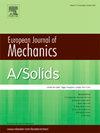C0 FEM approximation for the thermal buckling analysis of thin plates: Lagrange Multiplier and Penalty Methods
IF 4.4
2区 工程技术
Q1 MECHANICS
引用次数: 0
Abstract
A FEM approximation for the thermal buckling of laminated thin plates employing the Lagrange Multiplier Method (LMM) and Penalty Method (PM) has been assessed. Such methods enforce internal constraints without requiring more complex formulations in a classical finite element implementation. Specifically, the thin plate assumption is applied in a first-order plate theory, eliminating the need for Hermite interpolation functions and complex meshing. Constraints are included in the formulation via energy functions. Applying the two methods enables the interpolation of displacement parameters using Lagrange shape functions with continuity. This approach simplifies implementation and enhances computational efficiency. In terms of model size, the Penalty Method (PM) does not introduce additional degrees of freedom (DOF). In contrast, the Lagrange Multiplier Method (LMM) increases the system’s DOF due to the inclusion of Lagrange multipliers. For the case of LMM, the regularization method has been utilized to solve the saddle point problem. A parametric study has been carried out for the critical buckling temperatures of laminated thin plates. To verify the effectiveness of the proposed method, results were compared with known analytical solutions and other conventional approaches, demonstrating strong agreement. Comparing the two methods shows that both LMM and PM simplify implementing numerical algorithms for optimal solutions in computational environments.

求助全文
约1分钟内获得全文
求助全文
来源期刊
CiteScore
7.00
自引率
7.30%
发文量
275
审稿时长
48 days
期刊介绍:
The European Journal of Mechanics endash; A/Solids continues to publish articles in English in all areas of Solid Mechanics from the physical and mathematical basis to materials engineering, technological applications and methods of modern computational mechanics, both pure and applied research.

 求助内容:
求助内容: 应助结果提醒方式:
应助结果提醒方式:


